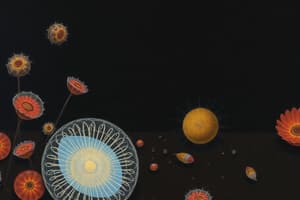Podcast
Questions and Answers
What feature distinguishes unicellular organisms from multicellular organisms?
What feature distinguishes unicellular organisms from multicellular organisms?
- Unicellular organisms are typically larger than multicellular organisms.
- Unicellular organisms consist of a single cell. (correct)
- Unicellular organisms are always microscopic.
- Unicellular organisms often reproduce faster.
Which of the following tasks is shared by both animal and plant cells?
Which of the following tasks is shared by both animal and plant cells?
- Photosynthesis
- Producing seeds
- Absorbing water through roots
- Taking in food (correct)
Which statement about cell structure is true?
Which statement about cell structure is true?
- Plant cells have a prominent cell wall. (correct)
- Animal cells are larger and square-shaped.
- Animal cells contain chlorophyll for photosynthesis.
- Plant cells do not release energy.
What is a common characteristic of all living organisms?
What is a common characteristic of all living organisms?
What does it mean for cells to be microscopic?
What does it mean for cells to be microscopic?
Flashcards are hidden until you start studying
Study Notes
Cellular Organisation
- All living organisms are composed of cells.
- Unicellular organisms, such as bacteria, consist of a single cell.
- Multicellular organisms, including most plants and animals, are made up of millions of interconnected cells.
- Cells are microscopic, requiring a microscope for visibility.
Functions of Cells
- Main functions of both animal and plant cells include:
- Ingestion of food: Cells take in necessary nutrients.
- Energy release: Cells utilize food to produce energy.
- Waste elimination: Cells expel byproducts and waste materials.
- Growth: Cells undergo processes to increase in size and number.
- Reproduction: Cells divide to create new cells.
Structural Differences
-
Animal Cells:
- Typically small, round, and pinkish in appearance.
- Characterized by a darker purple nucleus.
-
Plant Cells:
- Generally larger and square in shape.
- Contain numerous green circles (chloroplasts) for photosynthesis.
- Feature a notable darker green cell wall providing structure and protection.
Studying That Suits You
Use AI to generate personalized quizzes and flashcards to suit your learning preferences.



